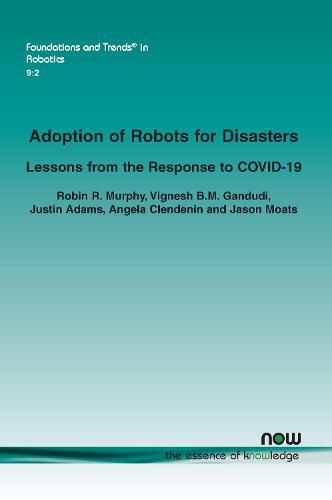Readings Newsletter
Become a Readings Member to make your shopping experience even easier.
Sign in or sign up for free!
You’re not far away from qualifying for FREE standard shipping within Australia
You’ve qualified for FREE standard shipping within Australia
The cart is loading…






This title is printed to order. This book may have been self-published. If so, we cannot guarantee the quality of the content. In the main most books will have gone through the editing process however some may not. We therefore suggest that you be aware of this before ordering this book. If in doubt check either the author or publisher’s details as we are unable to accept any returns unless they are faulty. Please contact us if you have any questions.
This publication describes how robot innovations are adopted during a disaster using the COVID-19 response, both as a natural experiment and a case study. While the reports do not provide full details to ascertain gaps in specific algorithms or specific subsystems, the size and the pervasiveness of the data permits examination of three questions, namely: how the need for a robot arises during a disaster; whether those needs are met with existing technically mature robots, adapting existing robots, or innovating new robots; and what are the major barriers to inserting robots into use during a disaster. The analysis utilizes a novel formal framework consisting of a sociotechnical work domain analysis, an extended demand analysis, and a rating of the technical maturity of each instance using the NASA Technical Readiness Assessment (TRA) ranking. Also covered are related works in modeling the adoption of robots and prior summative of the use of robots for the coronavirus pandemic, as well as a novel framework for analysis is discussed in detail. An analysis is also made of all Heritage systems, Engineering systems, and New systems. The paper concludes with findings for disaster robotics, then uses the model of adoption to make four recommendations for roboticists interested in developing and deploying technology for a disaster. This publication provides an in-depth overview and practical examples of how robots can be deployed during a disaster. As such it should prove useful for roboticists, researchers in various fields related to robotics as well as industry professionals who are responsible for saving lives and mitigating societal impacts in times of disaster.
$9.00 standard shipping within Australia
FREE standard shipping within Australia for orders over $100.00
Express & International shipping calculated at checkout
This title is printed to order. This book may have been self-published. If so, we cannot guarantee the quality of the content. In the main most books will have gone through the editing process however some may not. We therefore suggest that you be aware of this before ordering this book. If in doubt check either the author or publisher’s details as we are unable to accept any returns unless they are faulty. Please contact us if you have any questions.
This publication describes how robot innovations are adopted during a disaster using the COVID-19 response, both as a natural experiment and a case study. While the reports do not provide full details to ascertain gaps in specific algorithms or specific subsystems, the size and the pervasiveness of the data permits examination of three questions, namely: how the need for a robot arises during a disaster; whether those needs are met with existing technically mature robots, adapting existing robots, or innovating new robots; and what are the major barriers to inserting robots into use during a disaster. The analysis utilizes a novel formal framework consisting of a sociotechnical work domain analysis, an extended demand analysis, and a rating of the technical maturity of each instance using the NASA Technical Readiness Assessment (TRA) ranking. Also covered are related works in modeling the adoption of robots and prior summative of the use of robots for the coronavirus pandemic, as well as a novel framework for analysis is discussed in detail. An analysis is also made of all Heritage systems, Engineering systems, and New systems. The paper concludes with findings for disaster robotics, then uses the model of adoption to make four recommendations for roboticists interested in developing and deploying technology for a disaster. This publication provides an in-depth overview and practical examples of how robots can be deployed during a disaster. As such it should prove useful for roboticists, researchers in various fields related to robotics as well as industry professionals who are responsible for saving lives and mitigating societal impacts in times of disaster.